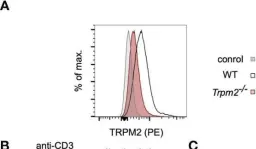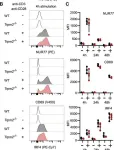Platelets, known for maintaining blood balance, also participate in antimicrobial defense. Upon severeacute respiratory syndrome coronavirus 2 (SARS-CoV-2) infection, platelets become hyperactivated, releasing molecules such as cytokines, granule contents, and bioactive lipids. The key effector biolipids produced by platelets include 12-hydroxyeicosatetraenoic acid (12-HETE) and 12-hydroxyeicosatrienoic acid (12-HETrE), produced by 12-lipoxygenase (12-LOX), and prostaglandins and thromboxane, produced by cyclooxygenase-1. While prostaglandin E2 and thromboxane B2 were previously associated with lung inflammation in severe COVID-19, the role of platelet 12-LOX in SARS-CoV-2 infection remains unclear. Using mice deficient for platelets' 12-LOX, we report that SARS-CoV-2 infection resulted in higher lung inflammation characterized by histopathological tissue analysis, increased leukocyte infiltrates, and cytokine production relative to wild-type mice. In addition, distinct platelet and lung transcriptomic changes, including alterations in NOD-like receptor (NLR) family pyrin domain-containing 1 (NLRP1) inflammasome-related gene expression, were observed. Mass spectrometry lipidomic analysis in 12-LOX-deficient-infected mice revealed significant changes in bioactive lipid content, including reduced levels of 12-HETrE that inversely correlated with disease severity. Finally, platelet 12-LOX deficiency was associated with increased morbidity and lower survival rates relative to wild type (WT) mice. Overall, this study highlights the complex interplay between 12-LOX-related lipid metabolism and inflammatory responses during SARS-CoV-2 infection. The findings provide valuable insights into potential therapeutic targets aimed at mitigating severe outcomes, emphasizing the pivotal role of platelet enzymes in the host response to viral infections.
Product Citations: 18
In Proceedings of the National Academy of Sciences of the United States of America on 25 March 2025 by Dos S P Andrade, A. C., Lacasse, E., et al.
-
COVID-19
-
Immunology and Microbiology
In The Journal of Immunology on 1 May 2023 by Zhang, X., Ohayon-Steckel, L., et al.
Insulin resistance is a compromised response to insulin in target tissues such as liver. Emerging evidence shows that vascular endothelial cells (ECs) are critical in mediating glucose metabolism. However, how liver ECs can regulate inflammation in the setting of insulin resistance is still unknown. Using genome-wide transcriptome analysis of ECs isolated from diabetic mice, we found enrichment of the genes involved in epidermal growth factor receptor (Egfr) signaling. In line with this, hepatic sinusoidal ECs in diabetic mice had elevated levels of Egfr expression. Interestingly, we found an increased number of hepatic myeloid cells, especially macrophages, and systemic glucose intolerance in Cdh5Cre/+Egfrfl/fl mice lacking Egfr in ECs compared with littermate control mice with type II diabetes. Egfr deficiency upregulated the expression of MCP-1 in hepatic sinusoidal ECs. This resulted in augmented monocyte recruitment and macrophage differentiation in Cdh5Cre/+Egfrfl/fl mice compared with littermate control mice as determined by a mouse model of parabiosis. Finally, MCP-1 neutralization and hepatic macrophage depletion in Cdh5Cre/+Egfrfl/fl mice resulted in a reduced number of hepatic macrophages and ameliorated glucose intolerance compared with the control groups. Collectively, these results demonstrate a protective endothelial Egfr signaling in reducing monocyte-mediated hepatic inflammation and glucose intolerance in type II diabetic mice.
Copyright © 2023 by The American Association of Immunologists, Inc.
-
FC/FACS
-
Mus musculus (House mouse)
-
Immunology and Microbiology
Assessing lineage and cytolytic functional potential of murine tissue-resident innate lymphocytes.
In STAR Protocols on 17 March 2023 by Nixon, B. G., Chou, C., et al.
Group 1 innate lymphocytes are heterogeneous, and their ontogeny and function remain ambiguous. Here, we describe a protocol to measure cell ontogeny and effector functions of natural killer (NK) and ILC1 subsets based on current understanding of their differentiation pathways. We use cre drivers to genetically fate-map cells, tracking plasticity between mature NK and ILC1. We describe innate lymphoid cell precursor transfer studies that determine ontogeny of granzyme-C-expressing ILC1. Additionally, we detail in vitro killing assays that test cytolytic potential of ILC1s. For complete details on the use and execution of this protocol, please refer to Nixon et al. (2022).1.
Copyright © 2023 The Author(s). Published by Elsevier Inc. All rights reserved.
In Cell Reports Medicine on 15 November 2022 by Uceda-Castro, R., Margarido, A. S., et al.
An increasing number of breast cancer patients develop brain metastases (BM). Standard-of-care treatments are largely inefficient, and breast cancer brain metastasis (BCBM) patients are considered untreatable. Immunotherapies are not successfully employed in BCBM, in part because breast cancer is a "cold" tumor and also because the brain tissue has a unique immune landscape. Here, we generate and characterize immunocompetent models of BCBM derived from PyMT and Neu mammary tumors to test how harnessing the pro-senescence properties of doxorubicin can be used to prime the specific immune BCBM microenvironment. We reveal that BCBM senescent cells, induced by doxorubicin, trigger the recruitment of PD1-expressing T cells to the brain. Importantly, we demonstrate that induction of senescence with doxorubicin improves the efficacy of immunotherapy with anti-PD1 in BCBM in a CD8 T cell-dependent manner, thereby providing an optimized strategy to introduce immune-based treatments in this lethal disease. In addition, our BCBM models can be used for pre-clinical testing of other therapeutic strategies in the future.
Copyright © 2022 The Author(s). Published by Elsevier Inc. All rights reserved.
-
Mus musculus (House mouse)
-
Cancer Research
-
Immunology and Microbiology
In Nature Communications on 15 July 2022 by Ma, S., Zhao, Y., et al.
The hypoxic tumor microenvironment has been implicated in immune escape, but the underlying mechanism remains elusive. Using an in vitro culture system modeling human T cell dysfunction and exhaustion in triple-negative breast cancer (TNBC), we find that hypoxia suppresses immune effector gene expression, including in T and NK cells, resulting in immune effector cell dysfunction and resistance to immunotherapy. We demonstrate that hypoxia-induced factor 1α (HIF1α) interaction with HDAC1 and concurrent PRC2 dependency causes chromatin remolding resulting in epigenetic suppression of effector genes and subsequent immune dysfunction. Targeting HIF1α and the associated epigenetic machinery can reverse the immune effector dysfunction and overcome resistance to PD-1 blockade, as demonstrated both in vitro and in vivo using syngeneic and humanized mice models. These findings identify a HIF1α-mediated epigenetic mechanism in immune dysfunction and provide a potential strategy to overcome immune resistance in TNBC.
© 2022. The Author(s).
-
FC/FACS
-
Mus musculus (House mouse)
-
Cancer Research
-
Genetics
-
Immunology and Microbiology
In Front Immunol on 1 February 2022 by Lory, N. C., Nawrocki, M., et al.
Fig.2.A

-
FC/FACS
-
Collected and cropped from Front Immunol by CiteAb, provided under a CC-BY license
Image 1 of 2
In Front Immunol on 1 February 2022 by Lory, N. C., Nawrocki, M., et al.
Fig.2.B

-
FC/FACS
-
Collected and cropped from Front Immunol by CiteAb, provided under a CC-BY license
Image 1 of 2

